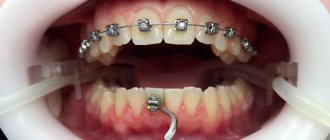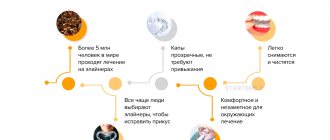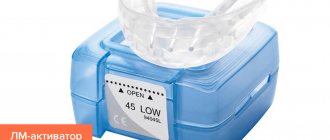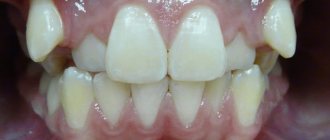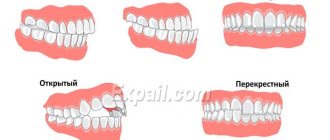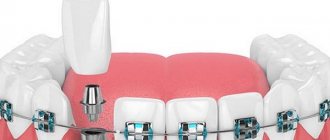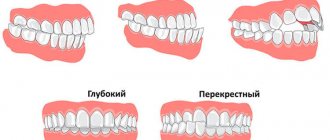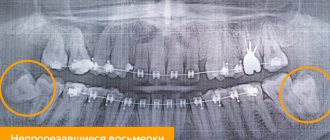If ten years ago someone had told you that wearing a device to correct your bite after forty years was normal, you would hardly have believed him. But today, more and more forty-year-old patients are resorting to such therapy, and one can even say that it has become fashionable.
Perhaps we should thank Madonna, Cindy Crawford, Gwen Stefani and other world-class superstars for this. Celebrities are increasingly appearing in public, proudly flaunting a smile adorned with braces. Some of them consciously prefer devices that attract attention.
Well, long live this fashion, because thanks to it, correcting the bite with braces after forty years is gaining momentum and helps maintain dental health in the second half of life. More and more people of this age can get the smile they have only dreamed of until now.
But the matter, of course, is not only about fashion coming from show business. Today, taking care of your health is a global trend. If earlier an orthodontic structure on the teeth of an adult caused surprise and could become the subject of jokes, today it only says that this person is seriously concerned about his health and image.
There is another important aspect due to which braces are becoming increasingly in demand by people in their fifties. We are talking about the manufacturing technologies of these devices and the process of their installation - they have become much more advanced and comfortable.
Braces today: installed faster, removed earlier
According to orthodontists, patients over the age of forty usually have characteristic doubts regarding treatment. They are concerned:
- how much do braces cost?
- how painful the therapy is;
- how long they will have to wear the braces.
A competent doctor will always try to dispel these doubts. At a consultation with an orthodontist, these doubts are completely dispelled. The doctor will tell you that the braces system causes inconvenience only in the first 2 weeks, until the patient adapts to them, and the treatment time depends on the complexity of the particular case. Today, the most minor problems with bite, such as mild crowding of teeth, can be solved in just 6-8 months. More severe cases may require removal of some molars and treatment for up to 30 months. But still, most often, orthodontic treatment takes 12-24 months, including orthodontic preparation, which is very relevant after 40 years, before rational prosthetics
Installation of braces after 40
When asked whether it is possible to wear braces after 40, the answer is definitely positive. Of course, there are some peculiarities in the treatment of such patients for which it is best to be prepared in advance. Firstly, this concerns the duration of wearing braces: it can last up to 3 years. This is due to the fact that the bone tissue of an adult has long been fully formed, so it is not easy to make any changes. Sometimes your doctor may order removal of a few units to make room for the remaining teeth to move.
The preparatory stage before installing the staples will also be longer. This is due to the fact that at this age a person probably has a large number of teeth affected by caries, and there are also pockets of inflammation. Before starting treatment, all problems should be eliminated, a complete sanitation of the oral cavity should be carried out, and implants or dentures should be installed.
In just a few years, even complex anomalies will be corrected, and there will be no trace left of complexes about one’s attractiveness. That is why you should not save time and money on your health, but it is better to start treatment in your youth. This will solve most dental problems in the future. However, many dentists like to work with the older generation, and there are several reasons for this.
The most popular orthodontic systems
The world of orthodontics offers so many options for straightening the teeth that it can be difficult to understand them, but the experienced doctors of the “Full Order” clinic in St. Petersburg will be happy to help each patient make the right choice!
Because of its accuracy and predictability of treatment, patients love the insignia digital braces system. The fact is that such a device is not created on an assembly line, but for each patient individually, with preliminary silicone impressions of the patient’s jaw or digital scanning of the dentition. .
In pursuit of high aesthetics, many patients strive to correct their bite so that neither friends nor work colleagues notice the treatment. In this case, doctors may recommend that they use lingual braces. These brackets are attached to the teeth from the inside, so no one except the orthodontist and his patient will know about their existence.
It is impossible not to mention such traditional metal systems for correcting bites as the famous Daimon braces, which continue to be popular and give excellent results. Thanks to them, patients can forget about those bulky “pieces of iron” that people of past generations wore. Today's fixation techniques, together with the smaller size of the device, do their job: braces look much less bulky and are comfortable to wear.
Until recently, metal braces could only be seen on a child or teenager, and because of this, many adults feel that this device makes them look childish. But just look around and calm down: a huge number of mature people are treated by orthodontists!
It is necessary to say a few words about the Damon clear bracket system, whose advantages are transparency, the absence of ligatures and the good sliding of the arch due to this fact. Thanks to the latest quality, the treatment process is slightly accelerated, and the intervals between necessary visits to the clinic for planned activations increase. In this case, the patient can count on a faster and more convenient solution to his bite problems.
What should you prepare for mentally?
- Patients over 40 do not lack motivation, but they will certainly need patience. To form the correct bite, you will have to move and rotate your teeth, and to do this you will have to find free space in the jawbone. With a long-formed skeletal system, this will not be easy, and you may even have to remove one or two teeth.
- At the preparatory stage, you will have to engage in high-quality sanitation of the oral cavity: cure caries, improve gum health, and, if necessary, perform prosthetics or dental implants.
- Finally, you need to realize that at 40 years old, correction will take several times longer than at 15 years old.
There is no point in regretting that the bite was not corrected in a timely manner during adolescence. Even one and a half to two years will not be wasted. The investment of money and time will fully compensate for straight teeth and the self-confidence acquired with them. In addition, treatment at this age has certain advantages.
Patient reviews about treatment
Patients forty years and older who decided to correct their bite say that in the first days after installing braces, it seemed to them that all the eyes of those around them were focused only on their teeth. But later they noticed that no one paid attention to the orthodontic structure on their teeth, but their attitude towards their appearance changed for the better.
Other patients say they were worried about not being able to eat their favorite foods, but the fears were unfounded. Of course, they had to temporarily stop biting apples, gnawing nuts or enjoying Chinese noodles, which tended to entangle themselves with the installed braces, but in general they did not have to change their diet much.
That is why, with regard to correcting the bite after forty, we can draw the following conclusion: age does not matter when correcting the bite, since it is never too late to start taking care of your health and appearance!
The advantage of interacting with adult patients
Most often, children wear braces solely because of the wishes of their parents. Therefore, it can be quite difficult to convince them of the need for careful, daily care and diet. In addition, at this age there are no necessary self-discipline skills, which can cause many problems. As a result, after removing braces, children are diagnosed with extensive carious lesions or other pathologies, which can be quite difficult to correct even for the most experienced specialist.
Adults approach the issue of correcting their bite much more responsibly; they follow all the recommendations of their treating doctor. Most people over 40 are completely financially independent, so they can afford to install the most aesthetically attractive and comfortable structures made of ceramics or sapphire.
Such patients are mentally prepared for the upcoming difficulties and really want to achieve an excellent result. Adults are sincerely grateful to doctors who help them get a perfect smile.
previous post
Pain from braces
next entry
Braces cause allergies
There are very few contraindications to braces. Mainly these are dental, neurological and joint diseases. A tendency to an allergic reaction is not a limitation to orthodontic treatment. If a patient is allergic to any material (for example, metal), then a brace system is selected for him, the elements of which are made of a different material. Modern designs can be made individually and have hypoallergenic properties.
There is no need to be afraid of treating malocclusion with braces. The orthodontic design copes even with serious dental defects. All myths about braces are relics of the past, guesswork or unsuccessful treatment experiences from unqualified doctors. A decisive step towards correcting your bite with braces is a step towards a healthy and beautiful smile.
Why do adults need braces and features of bite correction?
If you are already twenty, thirty or older, and you have come to terms with the deficiency, then should you contact an orthodontist? Modern dentistry gives a clear affirmative answer. If in youth, incorrect occlusion and crooked teeth brought only aesthetic dissatisfaction, then over the years factors can become the cause:
- Gastrointestinal diseases, metabolic disorders due to poor nutrition or insufficient grinding of food.
- Increasing displacement of the jaws affects the joints, arthritis or arthrosis develops, nerve endings are pinched, and headaches of unknown etiology appear.
- Changes in posture, further distortion of facial proportions.
But there are nuances that I always tell patients about during their first visit. Treatment with braces for adults lasts longer: the bone has already become stronger, and the teeth have confidently assumed the wrong position. Therefore, it will take more time to “move” problematic teeth. Sometimes it takes 1-2-3 years. But the aesthetic and functional result will stay with you for life and it’s worth it, believe me.
There are also features of correcting the bite and position of the teeth in adults: it may be necessary to remove wisdom teeth - this is necessary when the crowding of the teeth is great and there is not enough space for the placement of molars, incisors, and fangs.
SHOULD I CORRECT BITE AT 40 YEARS OLD? CONTRAINDICATIONS.
Patients over 30–40 years of age have more health problems than adolescent patients. Therefore, the list of contraindications to installing a brace system increases significantly. The main reasons for refusal to treat an anomaly:
- The patient is missing most of his natural teeth.
- Presence of cancer. Installation of the structure is possible only after the patient has completely recovered from cancer.
- The patient has mental disorders in the form of: paranoia, dementia, schizophrenia or similar deviations. The reason for refusal in this case is that the patient will not be able to guarantee compliance with all the requirements and recommendations that will need to be followed while wearing the braces system. In addition, during the period of exacerbation of such diseases, a person can harm himself with orthodontic construction.
- The patient has abnormalities in the skeletal system - osteonecrosis, osteopathy and osteoporosis. These diseases can provoke dysplasia of bone tissue and, accordingly, problems with their healing, therefore they are also included in the list of contraindications.
- The presence of periodontal disease or periodontitis. These diseases are accompanied by weak fixation of the tooth in the gum. The braces system is a fairly massive structure for the teeth, so they will not be able to withstand its pressure. After successful treatment of these diseases, installation of the system is permitted.
- It is not recommended to install braces for pathologies of the vascular system, which are accompanied by coughing, shortness of breath or uneven heartbeat.
- The presence of severe blood diseases, for example, leukemia. Treatment of the underlying disease is accompanied by complex procedures that may serve as a contraindication to the installation of structures.
- The installation of braces is also contraindicated in cases of established pathology in the temporomandibular joint, which is accompanied by severe pain, but if the underlying problem is successfully treated, the contraindications are invalid.
- The patient has tuberculosis, since this disease involves infection of the entire body.
And of course, braces are not installed in the presence of severe pathologies of the immune system, HIV infections and sexually transmitted diseases.
Which braces are better to choose?
The choice of system for a person aged between 40 and 50 years depends on the type and severity of the pathology. In severe cases, there is only one option - metal braces. They can also be recommended to those who are determined to get quick results and are not embarrassed by iron braces in their mouth. An additional advantage of metal braces is their affordable price, especially when it comes to a ligature-free system.
A ligature (from the Latin ligare - binding) is a wire or rubber ring that connects the power arc with each bracket part. Ligatures hold the archwire in the bracket grooves and prevent it from moving. However, they quickly become unusable, stretch, stain and therefore need regular replacement. This increases the treatment period and obliges the patient to visit the orthodontist once every month or month and a half.
Non-ligating (self-ligating) structures have become a breakthrough in orthodontic treatment: the braces in them are attached to the arch with snap-clips that are not subject to deformation and staining.
Due to the absence of ligatures, the friction force in the grooves is minimal, and the teeth do not have to overcome unnecessary resistance. The advantage of self-ligating braces is aesthetics. The system is not overloaded with details, due to which the smile is significantly “lightened”.
Attractive in appearance, but fragile and capricious - this is about ceramic and sapphire braces. Such systems are hardly noticeable on the teeth and are comfortable to wear, but are less effective and more expensive compared to metal ones.
Important!
For public and shy people, the doctor may recommend lingual braces, which are attached to the inside of the teeth.
Alternative ways to straighten teeth
An alternative to braces can be clear aligners that can be removed while eating and brushing your teeth. This is a relatively new device that appeared about 15 years ago. In terms of treatment effectiveness, mouthguards are inferior to braces, but have a number of advantages:
- do not injure the mucous membranes of the mouth and do not impair diction;
- practically invisible to others: they can only be seen at close range, no more than three steps;
- do not have a negative effect on tooth enamel, the risk of developing caries when wearing mouth guards does not increase;
- Teeth brushing is carried out in the same way as before, and there are no restrictions on food.
Important!
Braces use a metal arch that is deformed in advance, and it lasts for about a month. In aligner trays, plastic acts as the “power engine” of teeth, capable of bending no more than 0.25 mm. When one mouthguard has worn out, it is replaced with a new one.
Disadvantages of caps:
- high price, an order of magnitude higher than that of braces, the cost directly depends on the severity of the pathology;
- they don’t always help, so in some cases the patient first wears braces, and then, at the final stage, uses mouthguards;
- If you don’t wear mouth guards at least 22 hours a day, there will be no effect. You can and should take them off several times a day, but put them on again immediately after meals or hygiene procedures. Many people forget or put off putting them on, as it causes severe discomfort.
Types of braces for adults
In addition to their useful qualities and their task of correcting the bite, modern braces can also become a worthy decoration on the teeth. Depending on the patient’s preferences and clinical picture, the following designs may be preferred:
- Stylish, efficient and inexpensive metal.
- Invisible ceramic.
- Beautiful, creating a special image, sparkling sapphire.
- Technological, requiring a minimum number of visits to the doctor, self-regulating.
Depending on the indications, other orthodontic systems of different brands are used.
How to find out if braces are needed
Correcting a bite with braces is, first of all, a medical procedure, and therefore only a qualified dentist can determine the indications for it. But many people, especially parents of small children, are concerned with the question: “Are braces necessary or will it just go away on its own?” Indeed, this is an important question, because you must initiate a visit to the doctor yourself.
Orthodontists at the “Smile” dental chain advise you to seek help from a dentist if you notice the following symptoms:
- the teeth grow very crowded, that is, they “climb” on top of each other;
- gaps are visible in the dentition;
- there is a lisp in the diction;
- sometimes the temporal mandibular joint hurts;
- in case there is a visually noticeable violation of the closure of the jaws. There are several variants of the defect that you can determine yourself. This is a deep, open, cross, distal or mesial bite. The figure below is a visual representation of them.
Important:
Ignoring the symptoms described above can lead to unpleasant and even dangerous consequences for human health. These include: indigestion, diseases and loss of teeth, frequent headaches.
